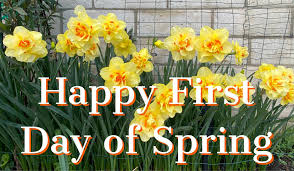The first day of spring in 2025, known as the spring equinox, falls on Thursday, March 20, at 5:01 a.m. EDT (2:01 a.m. PDT). This date marks the official start of the spring season in the Northern Hemisphere and is a moment when the Earth experiences nearly equal amounts of daylight and darkness. It is a time that many people around the world recognize not just as a change in the weather, but also as a powerful symbol of renewal, growth, and transformation. The arrival of spring often brings with it a sense of hope and excitement, as nature begins to wake up from the cold winter months, and new life begins to flourish.
The spring equinox holds both astronomical and cultural significance, and it is celebrated in various ways across the globe. In this blog post, we’ll explore the scientific aspects of the spring equinox, the cultural traditions associated with this day, and why it’s considered such a special and meaningful event.
Understanding the Spring Equinox

The spring equinox is one of the two times each year (the other being the autumnal equinox) when the Earth’s axis is perpendicular to the Sun’s rays. This means that the Sun shines directly on the equator, and as a result, day and night are approximately equal in length all over the planet. The word “equinox” comes from the Latin terms aequus (equal) and nox (night), signifying the balance of day and night.
As the equinox approaches, the tilt of the Earth’s axis means the Northern Hemisphere begins to receive more direct sunlight, signaling the start of warmer temperatures and longer days. The spring equinox is a key astronomical event that heralds the transition from the cold, dormant months of winter to the warmer, more active season of spring.
The Astrological Significance of the Spring Equinox

In astrology, the spring equinox marks the beginning of the astrological new year. This is when the Sun enters Aries, the first zodiac sign, bringing with it qualities of renewal, action, and fresh starts. Aries is a sign associated with enthusiasm, courage, and leadership, which makes the equinox a perfect time for setting new intentions and embracing new projects. Many people use this time to reflect on their goals, aspirations, and personal growth, and it is seen as an ideal opportunity for embarking on new endeavors.
Astrologically, the spring equinox is a time of balance and harmony. The Sun’s position relative to the Earth allows for a perfect balance of light and dark, and it’s a time when energy and opportunities for growth are in perfect alignment. This makes the equinox a powerful time for spiritual renewal, self-reflection, and growth.
Global Celebrations and Traditions

Across the world, the spring equinox has been celebrated for centuries. Many cultures see it as a time for renewal, rejuvenation, and celebration of nature’s cycle. Here are a few of the notable traditions associated with the spring equinox:
- Nowruz – The Persian New Year
- One of the most significant celebrations on the spring equinox is Nowruz, the Persian New Year. This ancient festival is celebrated in countries like Iran, Afghanistan, and parts of Central Asia. Nowruz marks the beginning of the year in the Persian calendar and is observed with large gatherings, feasts, and rituals meant to welcome the new season. The celebration includes cleaning and decorating homes, wearing new clothes, and gathering with family and friends. Nowruz also emphasizes themes of renewal and rebirth, which are central to the spirit of spring.
- Chichen Itza – The Mayan Sun God
- In Mexico, thousands of people travel to the ancient Mayan pyramid of El Castillo at Chichen Itza to witness a spectacular natural phenomenon during the spring equinox. As the sun sets on this day, it creates a shadow on the pyramid’s steps that resembles a snake slithering down the structure. This phenomenon is linked to the Mayan god of the sun, Kukulkan, and draws attention to the Mayan civilization’s advanced understanding of astronomy. The equinox at Chichen Itza represents the balance between light and dark, a theme deeply ingrained in Mayan culture.
- Egg Balancing Tradition
- In several cultures, there is an old tradition of attempting to balance an egg upright on its end on the day of the equinox. The belief is that on this day, the Earth’s gravitational pull is perfectly balanced, making it possible for the egg to stand without support. While this is a fun and symbolic tradition, it is based on the concept of equilibrium that is central to the equinox.
- Celebrations in Japan
- In Japan, the Higan festival, which occurs around the time of the spring equinox, is a time for families to visit the graves of their ancestors and honor them. The word “Higan” means “the other shore” in Japanese, symbolizing the passage from the darkness of winter to the light of spring, and it is a time to reflect on spiritual growth and family connections.
The Importance of Spring Equinox in Modern Times

In today’s fast-paced world, the first day of spring often brings a renewed sense of hope and optimism. As the weather warms, people embrace outdoor activities, gardening, and spending time in nature. The long winter days are replaced with more sunlight, which has a positive effect on mood and energy levels. The spring equinox encourages people to spend time outdoors, connect with nature, and engage in activities that promote health and well-being.
In 2025, the arrival of spring is a time to appreciate the beauty of the natural world and to acknowledge the cyclical nature of life. Whether it’s planning new projects, engaging in self-reflection, or simply enjoying the longer days, the spring equinox is an ideal time to reset and focus on personal growth.
Conclusion

The first day of spring 2025, with its promise of renewal and new beginnings, offers a wonderful opportunity to celebrate not only the changing seasons but also the potential for growth and transformation in our own lives. From the astronomical significance of the equinox to the cultural traditions and modern-day celebrations, this day holds deep meaning for people around the world. Whether you are setting new goals, reflecting on your achievements, or simply basking in the joy of the season, the spring equinox is a reminder that the world is always evolving, and with it, so too can we.
Author Profile
- Syed Tahir Abbas is a Master's student at Southwest University, Chongqing, specializing in international relations and sustainable development. His research focuses on U.S.-China diplomacy, global geopolitics, and the role of education in shaping international policies. Syed has contributed to academic discussions on political dynamics, economic growth, and sustainable energy, aiming to offer fresh insights into global affairs.
Latest entries
 GeopoliticsAugust 23, 2025Previewing the White House Visit of South Korean President Lee Jae Myung
GeopoliticsAugust 23, 2025Previewing the White House Visit of South Korean President Lee Jae Myung Middle East ConflictJuly 22, 2025Israel’s Deadly Attacks on Gaza: A Dire Humanitarian Crisis and International Calls for a Truce
Middle East ConflictJuly 22, 2025Israel’s Deadly Attacks on Gaza: A Dire Humanitarian Crisis and International Calls for a Truce Middle East & North AfricaJuly 20, 2025Israel Targets Damascus Amid Rising Tensions in Syria
Middle East & North AfricaJuly 20, 2025Israel Targets Damascus Amid Rising Tensions in Syria Middle East AffairsJuly 14, 2025An Open Letter from Gaza’s University Presidents: Resisting Scholasticide Through Education
Middle East AffairsJuly 14, 2025An Open Letter from Gaza’s University Presidents: Resisting Scholasticide Through Education

